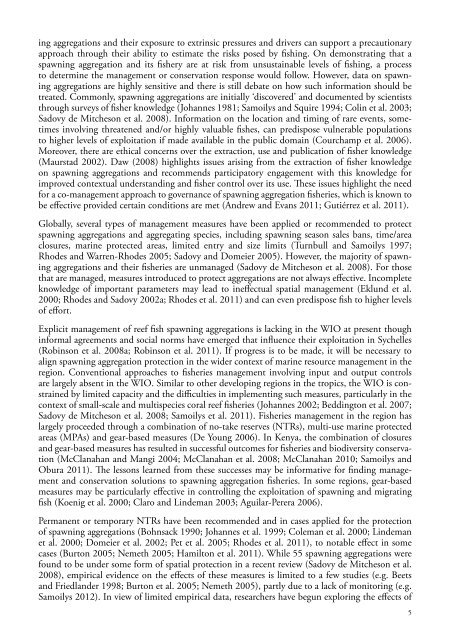WIOMSA-CORDIO spawning book Full Doc 10 oct 13.pdf
WIOMSA-CORDIO spawning book Full Doc 10 oct 13.pdf
WIOMSA-CORDIO spawning book Full Doc 10 oct 13.pdf
You also want an ePaper? Increase the reach of your titles
YUMPU automatically turns print PDFs into web optimized ePapers that Google loves.
ing aggregations and their exposure to extrinsic pressures and drivers can support a precautionaryapproach through their ability to estimate the risks posed by fishing. On demonstrating that a<strong>spawning</strong> aggregation and its fishery are at risk from unsustainable levels of fishing, a processto determine the management or conservation response would follow. However, data on <strong>spawning</strong>aggregations are highly sensitive and there is still debate on how such information should betreated. Commonly, <strong>spawning</strong> aggregations are initially ‘discovered’ and documented by scientiststhrough surveys of fisher knowledge (Johannes 1981; Samoilys and Squire 1994; Colin et al. 2003;Sadovy de Mitcheson et al. 2008). Information on the location and timing of rare events, sometimesinvolving threatened and/or highly valuable fishes, can predispose vulnerable populationsto higher levels of exploitation if made available in the public domain (Courchamp et al. 2006).Moreover, there are ethical concerns over the extraction, use and publication of fisher knowledge(Maurstad 2002). Daw (2008) highlights issues arising from the extraction of fisher knowledgeon <strong>spawning</strong> aggregations and recommends participatory engagement with this knowledge forimproved contextual understanding and fisher control over its use. These issues highlight the needfor a co-management approach to governance of <strong>spawning</strong> aggregation fisheries, which is known tobe effective provided certain conditions are met (Andrew and Evans 2011; Gutiérrez et al. 2011).Globally, several types of management measures have been applied or recommended to protect<strong>spawning</strong> aggregations and aggregating species, including <strong>spawning</strong> season sales bans, time/areaclosures, marine protected areas, limited entry and size limits (Turnbull and Samoilys 1997;Rhodes and Warren-Rhodes 2005; Sadovy and Domeier 2005). However, the majority of <strong>spawning</strong>aggregations and their fisheries are unmanaged (Sadovy de Mitcheson et al. 2008). For thosethat are managed, measures introduced to protect aggregations are not always effective. Incompleteknowledge of important parameters may lead to ineffectual spatial management (Eklund et al.2000; Rhodes and Sadovy 2002a; Rhodes et al. 2011) and can even predispose fish to higher levelsof effort.Explicit management of reef fish <strong>spawning</strong> aggregations is lacking in the WIO at present thoughinformal agreements and social norms have emerged that influence their exploitation in Sychelles(Robinson et al. 2008a; Robinson et al. 2011). If progress is to be made, it will be necessary toalign <strong>spawning</strong> aggregation protection in the wider context of marine resource management in theregion. Conventional approaches to fisheries management involving input and output controlsare largely absent in the WIO. Similar to other developing regions in the tropics, the WIO is constrainedby limited capacity and the difficulties in implementing such measures, particularly in thecontext of small-scale and multispecies coral reef fisheries (Johannes 2002; Beddington et al. 2007;Sadovy de Mitcheson et al. 2008; Samoilys et al. 2011). Fisheries management in the region haslargely proceeded through a combination of no-take reserves (NTRs), multi-use marine protectedareas (MPAs) and gear-based measures (De Young 2006). In Kenya, the combination of closuresand gear-based measures has resulted in successful outcomes for fisheries and biodiversity conservation(McClanahan and Mangi 2004; McClanahan et al. 2008; McClanahan 20<strong>10</strong>; Samoilys andObura 2011). The lessons learned from these successes may be informative for finding managementand conservation solutions to <strong>spawning</strong> aggregation fisheries. In some regions, gear-basedmeasures may be particularly effective in controlling the exploitation of <strong>spawning</strong> and migratingfish (Koenig et al. 2000; Claro and Lindeman 2003; Aguilar-Perera 2006).Permanent or temporary NTRs have been recommended and in cases applied for the protectionof <strong>spawning</strong> aggregations (Bohnsack 1990; Johannes et al. 1999; Coleman et al. 2000; Lindemanet al. 2000; Domeier et al. 2002; Pet et al. 2005; Rhodes et al. 2011), to notable effect in somecases (Burton 2005; Nemeth 2005; Hamilton et al. 2011). While 55 <strong>spawning</strong> aggregations werefound to be under some form of spatial protection in a recent review (Sadovy de Mitcheson et al.2008), empirical evidence on the effects of these measures is limited to a few studies (e.g. Beetsand Friedlander 1998; Burton et al. 2005; Nemeth 2005), partly due to a lack of monitoring (e.g.Samoilys 2012). In view of limited empirical data, researchers have begun exploring the effects of5


















